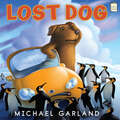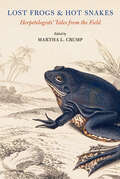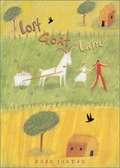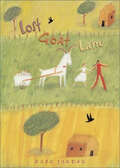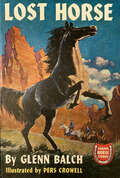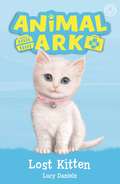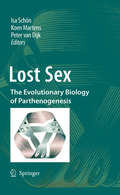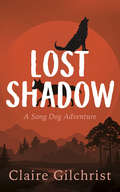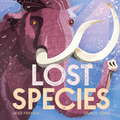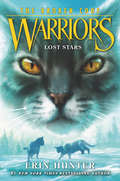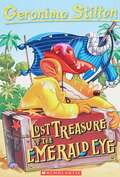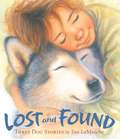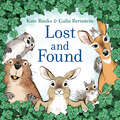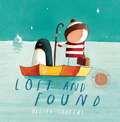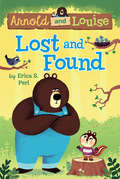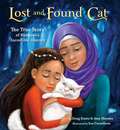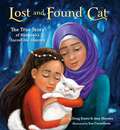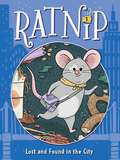- Table View
- List View
Lost Dog (I Like to Read)
by Michael GarlandWhen Pete sets off for Grandma's house, he runs into bad traffic. He tries a different route, and soon finds himself lost on a woodsy road. "Where is Mutt Street?" he asks a bear. "That way," the bear replies. As Pete follows directions from different animals he meets, he finds himself in the desert, the jungle and even the arctic! In this story of an accidental journey turned epic adventure, early readers will delight in all of Pete's stops along the way to Mutt Street, where Grandma is there to greet him. An I Like to Read® book for emerging readers. Guided Reading Level C.
Lost Frogs and Hot Snakes: Herpetologists' Tales from the Field
by Martha L. CrumpLost Frogs and Hot Snakes reveals the thrills and travails that herpetologists experience when working with amphibians and reptiles in the wild. With essays from fifty field biologists, this volume, edited by Martha L. Crump, presents a multifaceted yet intimate look at life in pursuit of knowledge about the natural world. From the beaches of Peru to the mountains of China, the stories in this collection place readers in the boots of field biologists as they watch, count, experiment, and survey. Some recall mishaps and misadventures—contending with leeches, dangling off a precipice while in a truck. Others tell of once-in-a-lifetime encounters—discovering a new frog species, spotting a rare snake. Together, these stories offer an understanding of what field biology is, what field biologists do, and how they go about doing it. Written with candor, warmth, and a dash of humor, the stories in Lost Frogs and Hot Snakes will encourage readers to appreciate the value of engaging with nature and of the amphibians and reptiles so critical to the vitality of our planet.
Lost Goat Lane
by Rosa JordanFor thirteen-year-old Kate, being poor in a small rural Florida town means feeling ashamed and isolated. At school, her classmates laugh at her old clothes and worn shoes. Things are not much better at home. Kate's mother is working long hours at a dairy farm to keep food on the table. Kate has to keep an eye on her brothers -- Justin is old enough to talk about running away, and Chip is young enough to keep wandering off. But one day, the family's goat gets loose and wanders down the road. That's when Kate meets the Wilsons, a tight knit, middle-class African-American family. Kate is particularly drawn to Ruby, the glamorous grown daughter who has returned home from New York City. As Kate begins to spend time with Ruby in town she becomes aware of the undercurrent of discrimination and prejudice that runs through her community, and the complex roles of race and class in her own relationships. Rosa Jordan offers readers a gripping, empathetic tale of how two families come together despite small town prejudices and cultural differences. In doing so, she provides a window into the larger problems in America, where class and race often divide people.
Lost Goat Lane
by Rosa JordanAn eloquent, dramatic story of an adolescent girl's first glimpse into the problems of prejudice in her community and the redeeming power of friendships.For thirteen-year-old Kate, being poor in a small rural Florida town means feeling ashamed and isolated. At school, her classmates laugh at her old clothes, and things are not much better at home. Kate's mother is working long hours just to keep food on the table, and Kate has to keep an eye on her brothers.But one day, the family's goat gets loose and wanders down the road. That's when Kate meets the Wilsons, a tight knit, middle-class Black family. Kate is particularly drawn to Ruby, the glamorous grown daughter who has returned home from New York City. As Kate begins to spend time with Ruby in town, she becomes aware of the undercurrent of discrimination and prejudice that runs through her community and the complex roles of race and class in her own relationships.Rosa Jordan offers readers a gripping, empathetic tale of how two families come together despite small town prejudices and cultural differences. In doing so, she provides a window into the larger problems in America, where class and race often divide people.
Lost Horse: Tack Ranch #3 (Famous Horse Stories)
by Glenn BalchWhen Tom Sample, a known scoundrel, brings Andy Blair to the Tack Ranch looking for his colt, bred from the famous horse Midnight Fire and stolen years ago, the Darbys doubt the colt could be King, the leader of a pack of wild horses nearby. But soon it is obvious he is the colt, now full-grown. Andy hires Tom and his men to capture the horse christened Midnight Chief, but known as King. The men use cruel and questionable tactics, but cannot capture the horse. When Andy learns the men have shot at least one of the wild horses, he fires Tom, and the Darbys must find King for Mr. Blair.
Lost Kitten: Book 9 (Animal Ark #9)
by Lucy DanielsHelping animals, having fun! The bestselling Animal Ark series has been reimagined for a new generation of children. Perfect for animal lovers and fans of Holly Webb and Magic Animal Friends. When Amelia and Sam find a lost white kitten in the wilderness, they can't work out why her behaviour seems different to other cats. With the help of the vets at Animal Ark, they work out that the lost kitten is deaf and help track down her owners. Because she can't hear, Tinkerbell is safer staying at home - but she really wants to explore outdoors. Can Amelia and Sam find a way to make the intrepid little kitten's garden safe but fun to play in?A brilliant animal series from multi-million-selling author Lucy Daniels, loved by parents and children alike!"I remember reading these books as a child myself. Now buying them for my own daughter. . . Delightful stories!" "I love this series of books. They made me realise how special animals are!"
Lost Pet Blues (Love Puppies)
by JaNay Brown-WoodAdorable dogs + a sprinkle of magic + a celebration of social emotional learning!Yip! Yip! Hooray! A little magic can save the day!The Love Puppies have a new mission: help Caleb find his missing pet! Noodles hopes they can come up with a paw-fect plan to bring Maximus home. Only, the furry friend is nowhere to be found! The puppies begin to wonder: will this be the first mission they fail to complete?With a little bit of magic and a whole lot of kindness, the Love Puppies are here to help kids overcome some tough social situations. Because with the power of love, anything is paw-sible!
Lost Sex
by Isa Schön Peter Van Dijk Koen MartensSex is the queen of problems in evolutionary biology. Generations of researchers have investigated one of the last remaining evolutionary paradoxes: why sex exists at all. Given that sexual reproduction is costly from an evolutionary point of view, one could wonder why not all animals and plants reproduce asexually. Dozens of contemporary hypotheses attempt to explain the prevalence of sex and its advantages and predict the early extinction of fully asexual lineages. The major theme of this book is: what is the fate of animal and plant groups in which sex is lost? Initial chapters discuss theory behind asexual life: what major disadvantages do asexual groups have to face, what are the genetic and ecological consequences and what does this theory predict for more applied aspects of asexual life, for example in agricultural pests, diseases as well as in cultural crops such as grapes. Cases studies in many animals (focusing on both invertebrates and vertebrates) and plants reveal parallel, but also singularly novel adaptations to the absence of meiosis and syngamy. And last but not least, are asexuals really doomed to early extinction or do genuine ancient asexuals exist? This book assembles contributions from the most important research groups dealing with asexual evolution in eukaryotes. It is a milestone in research on parthenogenesis and will be useful to undergraduate as well as graduate students and to senior researchers in all fields of evolutionary biology, as the paradox of sex remains its queen of problems.
Lost Shadow (Song Dog Adventure #2)
by Claire GilchristIn the sequel to Street Shadows, city coyote Pica is carried far away, into the land of wolves. Will she survive and make it back to Scruff?Winter is here, and coyotes Pica and Scruff are having trouble finding enough food to survive. Their only option may be to steal food from humans, which Scruff thinks is a necessary risk, while Pica thinks it’s too dangerous. After they get into a bitter fight, the unthinkable happens: Pica gets locked into a delivery truck and driven far away from the city, into the land of the wolves.When Pica disappears and doesn’t return for weeks, Scruff is devastated. He doesn’t know if the fight drove her away or if something happened to her. Not knowing what else to do, he eventually moves on and meets a new pack. However, these new friends rely heavily on human food, and he knows that by joining them he’s playing a dangerous game.Pica, alone in the wilderness, must call on all of her strength and courage to survive in this new landscape. She has to get back to Scruff before it’s too late. The clock is ticking, and leg traps, wolves, and a giant icy mountain range stand between Pica and her home.
Lost Species
by Jess FrenchStep into an incredible lost world and marvel at the strange and magnificent creatures that once roamed our Earth. From the awe-inspiring woolly mammoth and the ferocious Spinosaurus to the shy Chinese river dolphin and incredibly rare Pinta Island tortoise 'Lonesome George', meet 35 extinct species and discover how these creatures came under threat. Featuring additional information on 'Lazarus species' (animals declared extinct but which, amazingly, have been rediscovered in the wild), and mass extinction events, including the part we are playing in endangering our wildlife, the book shows young readers that extinction is not simply a part of ancient history - it is happening right now across the planet - but that if we all make some small changes to our lifestyles, our wonderful species can be saved. With beautiful and vibrant illustrations throughout, this stunning large format compendium is a reminder of the remarkable animals we have lost, as well as a celebration of those that have returned from the brink of extinction.
Lost Stars (Warriors: The Broken Code #1)
by Erin HunterFor the first time, all five warrior Clans have settled into their true homes in the territory around the lake. But when a shockingly harsh leaf-bare season descends on the forest, a new darkness begins to spread—a shadow that threatens a beloved Clan leader, the cats’ connection with their ancestors in StarClan, and the very warrior code they live by. <p><p> Packed with action and intrigue, the beginning of this sixth Warriors series is the perfect introduction for readers new to the Warriors world. And dedicated fans will be thrilled to discover the new adventures that unfold after the events of A Vision of Shadows.
Lost Tales of Ga'hoole (Guardians of Ga'Hoole)
by Kathryn Lasky Kathryn HuangGuided by the Knower, Otulissa has studied long in the libraries of the Others. Otulissa embarks on a journey to revitalize academic vigor and historical interest at the Great Tree. "Lost Tales of Ga'Hoole" is the result of her labor.
Lost Treasure Of The Emerald Eye
by Geronimo StiltonWho is Geronimo Stilton? That's me! I run a newspaper, but my true passion is writing tales of adventure. Here on Mouse Island, my books are all best-sellers! What's that? You've never read one? Well, my books are full of fun. They are whisker-licking good stories, and that's a promise! It all started when my sister, Thea, discovered a mysterious map. It showed a secret treasure on a faraway island. And before I could let out a squeak of protest, Thea dragged me into her treasure hunt! In no time at all, we'd set sail for the island. It was an adventure I'd never forget. . .
Lost Treasure of the Emerald Eye (Geronimo Stilton Series #1)
by Geronimo StiltonEnter the world of Geronimo Stilton, where another funny adventure is always right around the corner. Each book is a fast-paced adventure with lively art and a unique format kids 7-10 will love <p><p>Who Is Geronimo Stilton? That's me! I run a newspaper, but my true passion is writing tales of adventure. Here on Mouse Island, my books are all best-sellers! What's that? You've never read one? Well, my books are full of fun. They are whisker-licking good stories, and that's a promise! <p><p>Book 1 <p>It all started when my sister, Thea, discovered a mysterious map. It showed a secret treasure on a faraway island. And before I could let out a squeak of protest, Thea dragged me into her treasure hunt! In no time at all, we'd set sail for the island. It was an adventure I'd never forget....
Lost and Found
by Jacqueline SheehanAfter the sudden, unexpected death of her husband, Rocky moves to Peak's Island, Maine, and takes a job as an Animal Control Warden. She becomes involved with a wounded black Lab and several interesting neighbors and residents, solves a mystery, and finds romance and happiness. As an Animal Warden, Rocky experiences much of what real-life animal care and control professionals go through, from rescuing lost and injured pets and wildlife, to the heartbreak of finding pets abandoned by vacationers at the end of their stay, to resolving common conflicts with wildlife.
Lost and Found
by Jim LamarcheAnna looked all around her. The sky was getting dark. "I think we should go home now, Molly." But which way was home?In three heartwarming stories, celebrated illustrator Jim LaMarche lovingly depicts tales of being lost, being found, finding home, and, most important, the dogs who help us find our way. One lost dog is rescued, another pup leads a frightened child home, and a fractured family finds a fresh start through the love of a dog. Featuring exquisite artwork, this joyful, touching collection will be cherished by anyone who has ever loved a dog.
Lost and Found
by Kate BanksA story of woodland creatures discovering a lost doll is transformed into the perfect parable of love in this sweet, timeless picture book for fans of Corduroy and The Velveteen Rabbit.The wood mouse and the rabbit find a rag doll in the woods. Nothing about it is familiar: it doesn't smell like the fresh air of spring or feel like the rough bark of a tree. As the group of animals grows and searches for a clue to where the doll came from, they encounter more mysteries—and discover the one thing their hearts know to be true. Whether between parent and child, siblings, or friends, this beautifully illustrated story is about the way we show one other how much we care.
Lost and Found
by Oliver JeffersFrom the illustrator of the #1 smash hit The Day The Crayons Quit comes a humorously warm tale of friendship. Now also an animated TV special!What is a boy to do when a lost penguin shows up at his door? Find out where it comes from, of course, and return it. But the journey to the South Pole is long and difficult in the boy’s rowboat. There are storms to brave and deep, dark nights.To pass the time, the boy tells the penguin stories. Finally, they arrive. Yet instead of being happy, both are sad. That’s when the boy realizes: The penguin hadn’t been lost, it had merely been lonely.A poignant, funny, and child-friendly story about friendship lost . . . and then found again.
Lost and Found #2 (Arnold and Louise #2)
by Erica S. Perl Chris ChattertonUnlikely best friends Arnold and Louise--a big bear and a chatty chipmunk--are back in this easy-to-read chapter book series!When Louise borrows Arnold's newly found treasure, he's sure he'll never see it again. After all, she loses just about everything he lends her. Louise swears she hasn't lost it, but to get it back, she sends Arnold on a treasure hunt of her own--or is it a wild goose chase?
Lost and Found Cat: The True Story of Kunkush's Incredible Journey
by Sue Cornelison Doug Kuntz Amy Shrodes<p>This heartwarming true story about one lost cat's journey to be reunited with his refugee family gently introduces children to a difficult topic and shows how ordinary people can help with compassion and hope. <p>When an Iraqi family is forced to flee their home, they can't bear to leave their beloved cat, Kunkush, behind. So they carry him with them from Iraq to Greece, keeping their secret passenger hidden away. But during the crowded boat crossing to Greece, his carrier breaks and the frightened cat runs from the chaos. In one moment, he is gone. After an unsuccessful search, his family has to continue their journey, leaving brokenhearted. <p>A few days later, aid workers in Greece find the lost cat. Knowing how much his family has sacrificed already, they are desperate to reunite them with the cat they love so much. A worldwide community comes together to spread the word on the Internet and in the news media, and after several months the impossible happens--Kunkush's family is found, and they finally get their happy ending in their new home. <p>This remarkable true story is told by the real people involved, with the full cooperation of Kunkush's family.</p>
Lost and Found Cat: The True Story of Kunkush's Incredible Journey
by Doug Kuntz Amy ShrodesThis heartwarming true story of one lost cat's journey to be reunited with his refugee family gently introduces children to a difficult topic and shows how ordinary people can help with compassion and hope. When an Iraqi family is forced to flee their home, they can&’t bear to leave their beloved cat, Kunkush, behind. So they carry him with them from Iraq to Greece, keeping their secret passenger hidden away. But during the crowded boat crossing to Greece, his carrier breaks and the frightened cat runs from the chaos, disappearing. After an unsuccessful search, his family has to continue their journey, leaving brokenhearted. A few days later, aid workers in Greece find the lost cat. Knowing how much his family has sacrificed already, they are desperate to reunite them. A worldwide community comes together to spread the word on the Internet and in the news media, and after several months the impossible happens—Kunkush&’s family is found, and they finally get their happy ending in their new home. This remarkable true story is told by the real people involved, with the full cooperation of Kunkush&’s family.&“Bound to be a hit with cats and kids alike.&” —People.com
Lost and Found Pony (Pony Pals #29)
by Jeanne BetancourtAnna likes junior Pony Pals, Rosalie and Mimi. Over a walkie-talkie, Rosalie and Mimi say they're stuck in a cave. Pony Pals aren't sure they're telling truth. When a storm strikes, Rosalie, Mimi are still missing. It's up to Pony Pals to find them.
Lost and Found in the City (Ratnip #1)
by Cam HigginsIn this first book of the new chapter book series from the author of Good Dog, meet Ratnip, an adorable rat who goes on adventures in the city that are equal parts sweet and icky!Ratnip the rat lives in the City, where there&’s always plenty of food to eat…if you know where to look. Dumpster diving isn&’t just for finding food, though. It&’s also for discovering knick-knacks and adventure! And tonight, Ratnip is on a very special mission to return treasure to its rightful owner. But will he make it home before sunrise? With easy-to-read language and illustrations on almost every page, the Ratnip chapter books are perfect for beginning readers.
